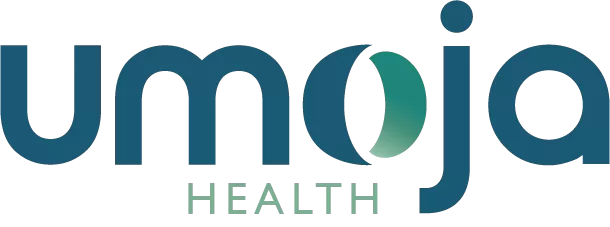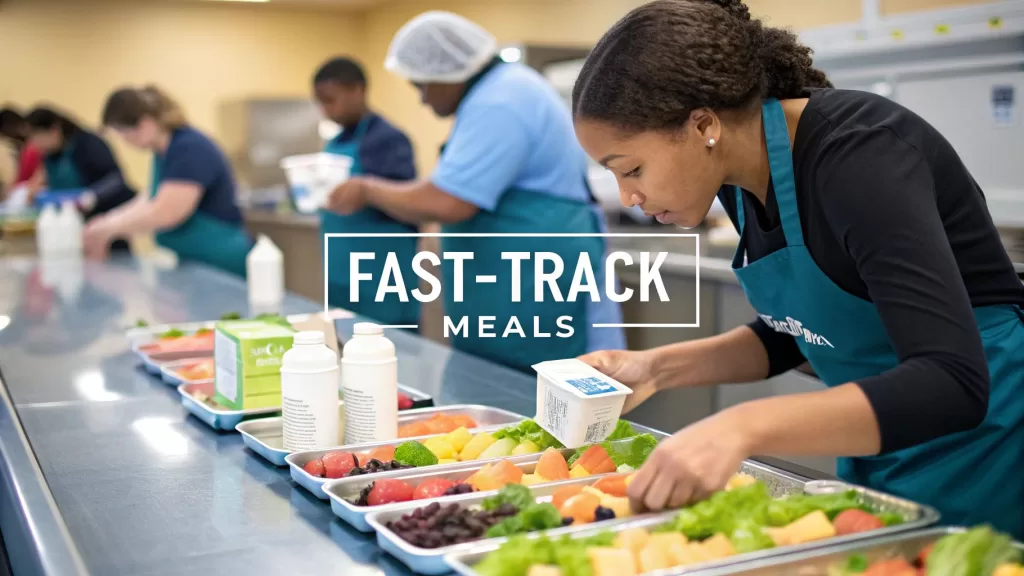An after-school meals provider is an organization that teams up with schools, community centers, and other sponsors to get nutritious meals to kids after the final bell rings. These providers are absolutely essential for closing the nutrition gap that so many students fall into, making sure they have the fuel they need to keep learning and growing long after school is out.
A truly successful partnership hinges on three things: rock-solid compliance with federal programs, smart distribution logistics, and a genuine understanding of what the local community actually needs. This guide will walk you through creating or scaling your program, from procurement and distribution to compliance and measuring outcomes.
Building Your Program on a Strong Foundation
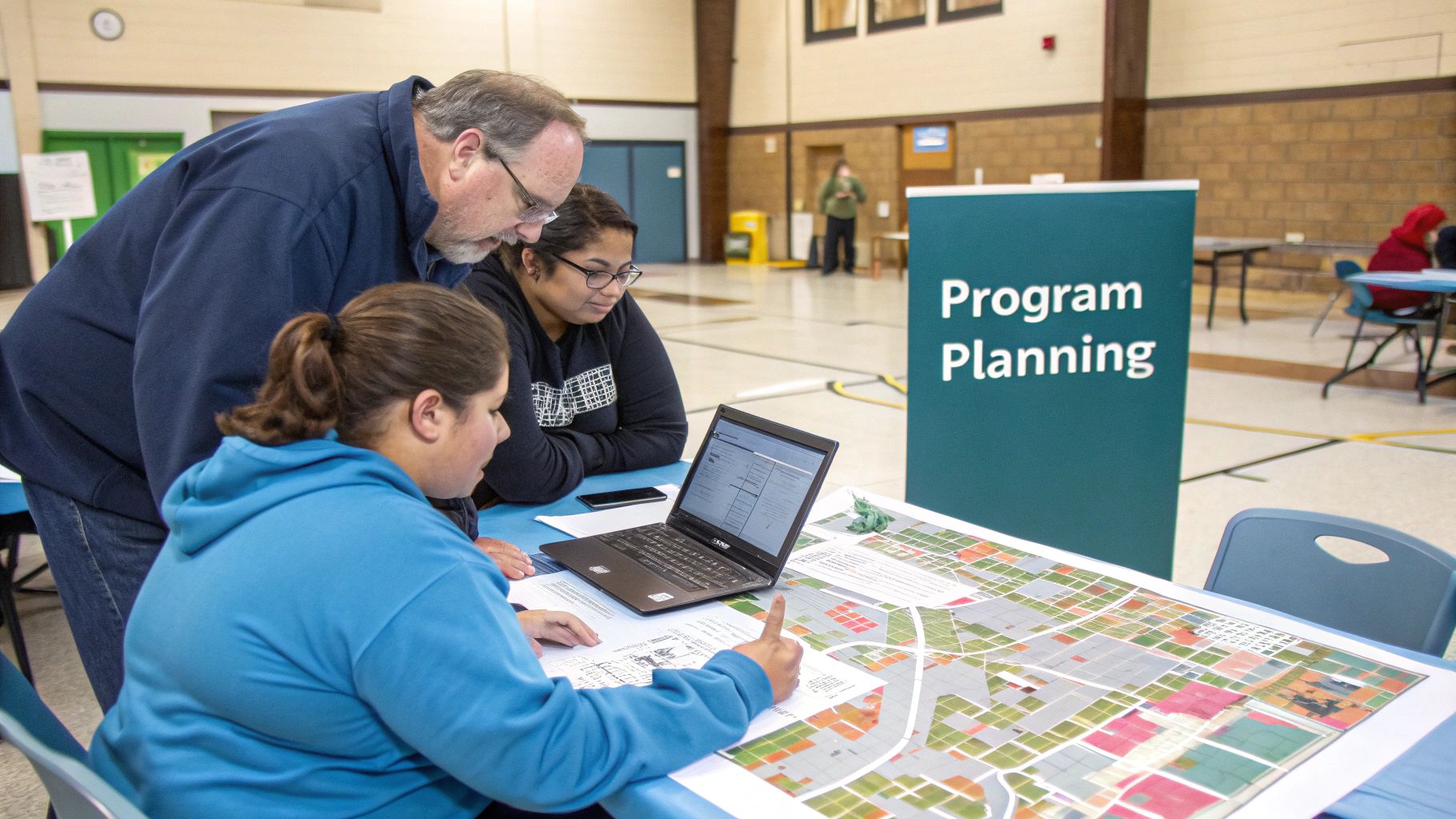
Before a single meal is ever served, a resilient and impactful after-school meals program starts with a solid strategic plan. This isn't just about figuring out logistics; it's about building a mission-driven operation that can weather challenges and truly serve its community. Getting this initial phase right ensures that every step that follows—from buying food to getting it into kids' hands—is aligned with a clear purpose.
The journey begins by getting to know the community you're setting out to serve. A thorough needs assessment is the bedrock of your entire program. This means going deeper than just identifying low-income areas. You need to dig into the specific, real-world challenges local families are up against.
- Mapping Underserved Areas: Use school district data and local public health statistics to pinpoint neighborhoods with the highest rates of food insecurity.
- Understanding Dietary Needs: Actually talk to community leaders, parents, and school nurses. Learn about common dietary restrictions, cultural food preferences, and any prevalent allergies.
- Identifying Logistical Barriers: Find out if things like transportation issues or parents' work schedules make it tough for families to get to traditional meal sites.
This deep dive gives you the concrete data you need to design a program that meets kids where they are, not where you hope they'll be.
Aligning Your Mission with Federal Programs
Once you have a clear picture of the community's needs, the next move is to build a framework that aligns with key federal child nutrition programs. Programs like the Child and Adult Care Food Program (CACFP) and the Summer Food Service Program (SFSP) provide the reimbursement structure that makes most meal programs financially possible. Your organization’s mission has to integrate their requirements seamlessly.
For a deeper understanding of these frameworks, take a look at our detailed overview of child nutrition programs and how they operate.
Case Example: Successful Rollout in an Urban Area
A community center in a mixed-income urban neighborhood wanted to launch a meals program. Their needs assessment showed that while plenty of families qualified for support, a huge number of them had parents working late shifts, making a 5 PM meal pickup impossible. By using this data, they got stakeholders on board for a "supper" program with a later pickup window. This directly addressed a proven community barrier and maximized participation right from the start.
Evaluating Your Capacity and Securing Funding
Finally, it's time for an honest look at your organization's own capacity. Do you have enough food storage space, especially refrigeration? Is your staffing model built to handle meal prep, distribution, and all the compliance paperwork? Answering these questions now will save you from major operational headaches down the road.
Securing a strong financial foundation is obviously paramount. Understanding how to find and win significant funding is key; it’s worth exploring a comprehensive guide to federal grants for nonprofits to get started. This essential groundwork—assessing needs, aligning your mission, and evaluating your capacity—creates the strategic blueprint for launching an after-school meals program that's truly built to last.
Getting Food Procurement and Program Compliance Right
Procurement and compliance are the real nuts and bolts of a successful after-school meals program. Let's be honest, the rules can look intimidating at first. But they’re all there for one reason: to make sure every child gets safe, nutritious food. Once you get the hang of it, that dense set of regulations becomes a straightforward, repeatable process that protects both your organization and the kids you serve.
The whole process kicks off with getting familiar with the main federal frameworks, which are usually the Child and Adult Care Food Program (CACFP) and the Summer Food Service Program (SFSP). These are the programs that provide the reimbursements that make everything possible, but they come with very specific strings attached.
Your procurement process absolutely has to be transparent, competitive, and meticulously documented. This isn't just bureaucratic red tape—it's one of the most common and expensive findings during an audit. You need a solid, consistent way of asking for bids from food service vendors.
Nailing the Language in Your Procurement Documents
When you put out a request for bids, your language has to be crystal clear. Vague requests are a recipe for disaster; you'll get proposals that don't fit your needs and create compliance headaches down the road.
- Get Specific on Meal Patterns: Don't just ask for "healthy meals." You need to explicitly state that all meals must meet CACFP or SFSP meal patterns. Go ahead and list the required components (e.g., milk, fruit/vegetable, grain, meat/meat alternate).
- Include the 'Buy American' Provision: This is a big one. You must require vendors to supply domestically grown and processed food as much as possible. It's a non-negotiable federal rule.
- Lay Out Your Delivery and Packaging Needs: Be precise about your delivery windows, temperature control (maintaining that critical cold chain), and exactly how you need meals packaged for easy distribution at your sites.
Getting this right from the start prevents a world of misunderstanding. It ensures you're comparing apples to apples when bids come in and builds the paper trail you need to prove you ran a fair competition. If you're looking to really tighten up your operations, you can explore the logistics solutions we offer that help make these very processes run like clockwork.
Choosing Your Vendors and Building Strong Contracts
Picking the right food service vendor is one of the most important decisions you’ll make. Don't just jump at the lowest price. Do your homework and look at their track record with organizations like yours. Can they actually handle the volume you need? Do they have a history of clean audits?
Once you've made your choice, the contract is your best friend for accountability. A rock-solid contract should always include:
- Detailed Menus: Don't leave it to chance. Attach sample multi-day menus right into the contract as an addendum.
- Termination Clauses: You need an exit strategy. Include language that lets you end the contract if the vendor fails to meet compliance or quality standards.
- Clear Invoicing Rules: Specify exactly what documentation you need to see—like delivery receipts and production records—before you'll pay an invoice.
Case Example: Streamlining Procurement for Scale
A nonprofit serving 50 sites was getting buried in disorganized bids. They completely turned it around by creating a standardized bid sheet. It forced vendors to itemize costs per meal component and confirm they met specific state health codes. This simple change cut their selection time in half and they sailed through their next audit with zero procurement findings.
Keeping Your Compliance Game Strong
Compliance isn't a "set it and forget it" task—it’s an ongoing effort. The way the world thinks about school meals has changed in a big way. It's not seen as just temporary aid anymore, but as a core investment in a child’s future.
We see this reflected in how programs are funded and structured globally. A staggering 107 countries now fund their own school meal programs, a huge jump from just 56 countries four years ago. Many of these programs are now requiring that a good portion of ingredients be sourced locally to support small farmers and strengthen the whole food system.
This global move toward local sourcing fits perfectly with the 'Buy American' provision and underscores why connecting with your local food system is so important. Keep an eye on government programs, too. For instance, state-level initiatives to boost local food access can unlock new funding and partnership opportunities you might have missed.
With a solid procurement foundation and a sharp eye on compliance, you can run an effective, audit-proof program with confidence.
To help you stay on track, we've put together a checklist of the most critical compliance areas to verify with any meal provider you work with.
Key Compliance Checks for Meal Program Providers
| Compliance Area | Verification Method | Frequency |
|---|---|---|
| Meal Pattern Adherence | Review menus and production records; conduct site observations during meal service. | Weekly / Monthly |
| 'Buy American' Provision | Request sourcing documentation; check product labels and invoices. | Quarterly / Annually |
| Food Safety & HACCP Plan | Review health inspection reports; request and verify the vendor's HACCP plan. | Annually & Spot Checks |
| Delivery & Cold Chain | Check temperatures upon delivery; review driver logs and vehicle conditions. | At Every Delivery |
| Record Keeping | Audit invoices, delivery receipts, and production records for accuracy and completeness. | Monthly |
| Staff Training | Request training logs for food handling, civil rights, and program rules. | Annually |
This table isn't exhaustive, but it covers the big items that auditors look for. Making these checks a routine part of your management process will save you a lot of stress in the long run.
Mastering Meal Production and Distribution
With procurement and compliance squared away, your focus can shift to the operational heart of your program: getting nutritious, safe, and appealing meals to children consistently. This is where your planning meets the pavement.
Success here hinges on precise workflows for everything from menu planning and food prep to final distribution. The goal is to make sure every single meal meets the highest standards of safety and quality.
From Menu Planning to Kitting Workflows
Effective menu planning is both an art and a science. It’s not enough to just meet federal nutritional guidelines; you have to create meals that kids will actually want to eat. A discarded meal, no matter how nutritious, helps no one.
This means balancing required components—like milk, whole grains, and fresh produce—with familiar, kid-friendly options. We've found that creating a multi-week menu cycle is a great way to prevent food fatigue and allows for more efficient purchasing. For example, a well-planned cycle might feature turkey and cheese sandwiches on whole wheat one day, followed by a yogurt parfait with granola and berries the next. This simple rotation ensures variety and component balance.
Once your menus are set, the next critical step is establishing efficient and safe kitting and packing workflows. This process is your first line of defense in food safety and consistency. Standard Operating Procedures (SOPs) are not just suggestions; they are essential for ensuring every meal bag or box is packed correctly and safely every time.
Your SOPs should cover a few key areas:
- Food Safety Protocols: Detail the non-negotiables like handwashing, glove use, and sanitizing surfaces to prevent cross-contamination.
- Portion Control: Use standardized scoops, scales, and containers to ensure each meal meets component requirements for reimbursement.
- Accurate Labeling: Every meal should be clearly labeled, especially those for children with documented allergies or dietary restrictions. This is critical.
A well-organized kitting line can make a world of difference in efficiency. For organizations managing complex logistics, exploring specialized kitting programs for nutrition security can provide the structure and support needed to scale operations without compromising on quality or safety.
Case Example: Improving Quality with Simple SOPs
A regional food bank serving 20 rural after-school sites was struggling with inconsistent meal quality and constant packing errors. By implementing a simple visual SOP—a laminated poster with pictures of a perfectly packed meal kit—they slashed packing errors by over 90%. This small change empowered volunteers and ensured every child received the correct, compliant meal.
Navigating Different Distribution Models
How you get meals from your kitchen to the children is just as important as how you prepare them. The right distribution model depends entirely on the community you serve. Traditional congregate dining, where children eat together on-site, is excellent for building community but isn’t always practical.
That's why many providers are now using innovative models to reach more children:
- Rural Non-Congregate Options: In sprawling rural areas, parent pick-up or even home delivery models are becoming vital. These require precise logistics to ensure meals remain at safe temperatures during transport.
- Hub-and-Spoke System: We see this a lot. One central kitchen prepares all meals, which are then transported to multiple smaller satellite sites for distribution. This centralizes quality control and really helps reduce costs.
This infographic shows the foundational compliance steps that underpin any successful distribution model.
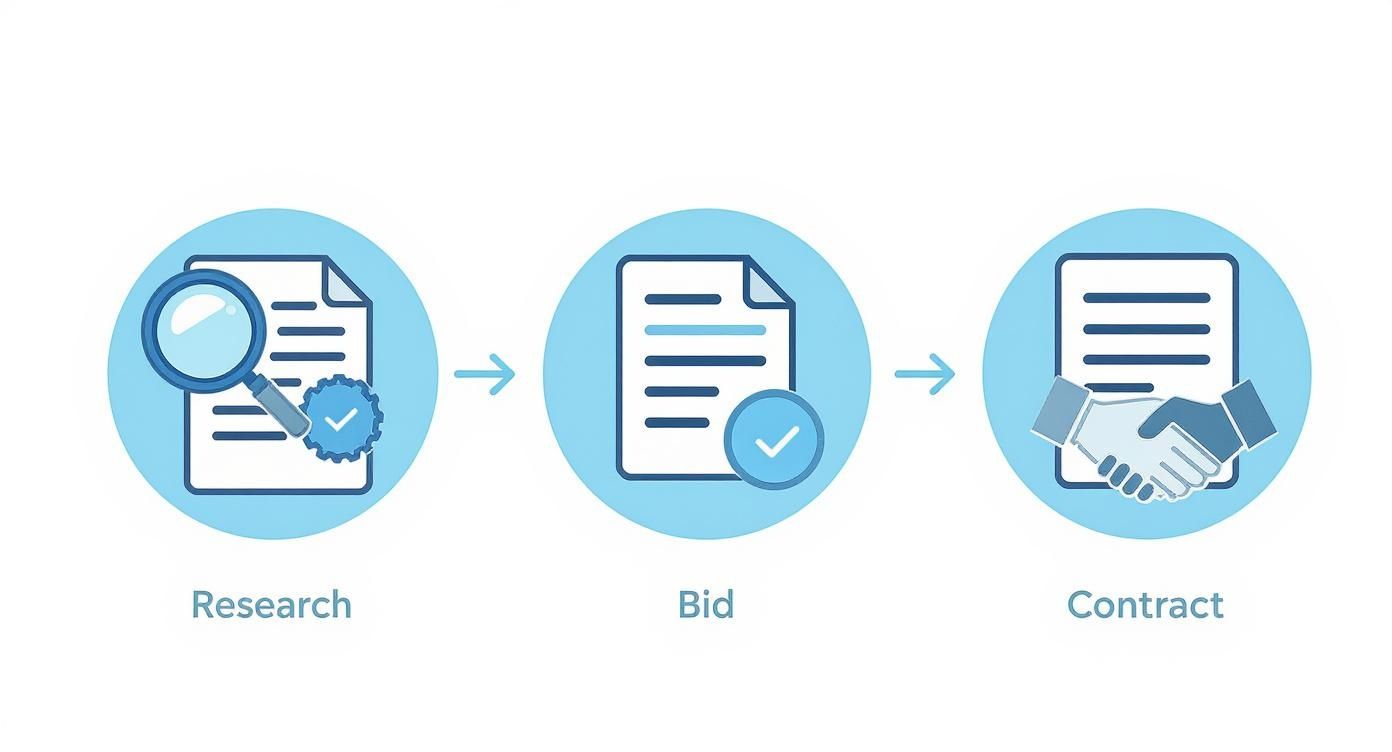
As the graphic shows, a strong, compliant contract is the outcome of diligent research and a fair bidding process—and it sets the stage for smooth operations from day one.
Maintaining the Critical Cold Chain
No matter your distribution model, maintaining the cold chain is non-negotiable. Perishable items like milk or yogurt absolutely must be kept below 41°F from the moment they leave your facility until they are in a child’s hands.
This requires a disciplined, documented approach to temperature management. Staff must be trained to use food thermometers and log temperatures at every critical point: upon receiving goods, during storage, and just before distribution. Using insulated transport bags or refrigerated vehicles is essential for any model that involves moving food off-site.
Handling exceptions is just as important. If a temperature log shows a deviation, you must have a clear protocol. Does the product get discarded? Can it be rapidly cooled back to a safe temperature? Having a plan in place prevents guesswork and, most importantly, protects the health of the children you serve.
Boosting Impact with Student and Parent Engagement
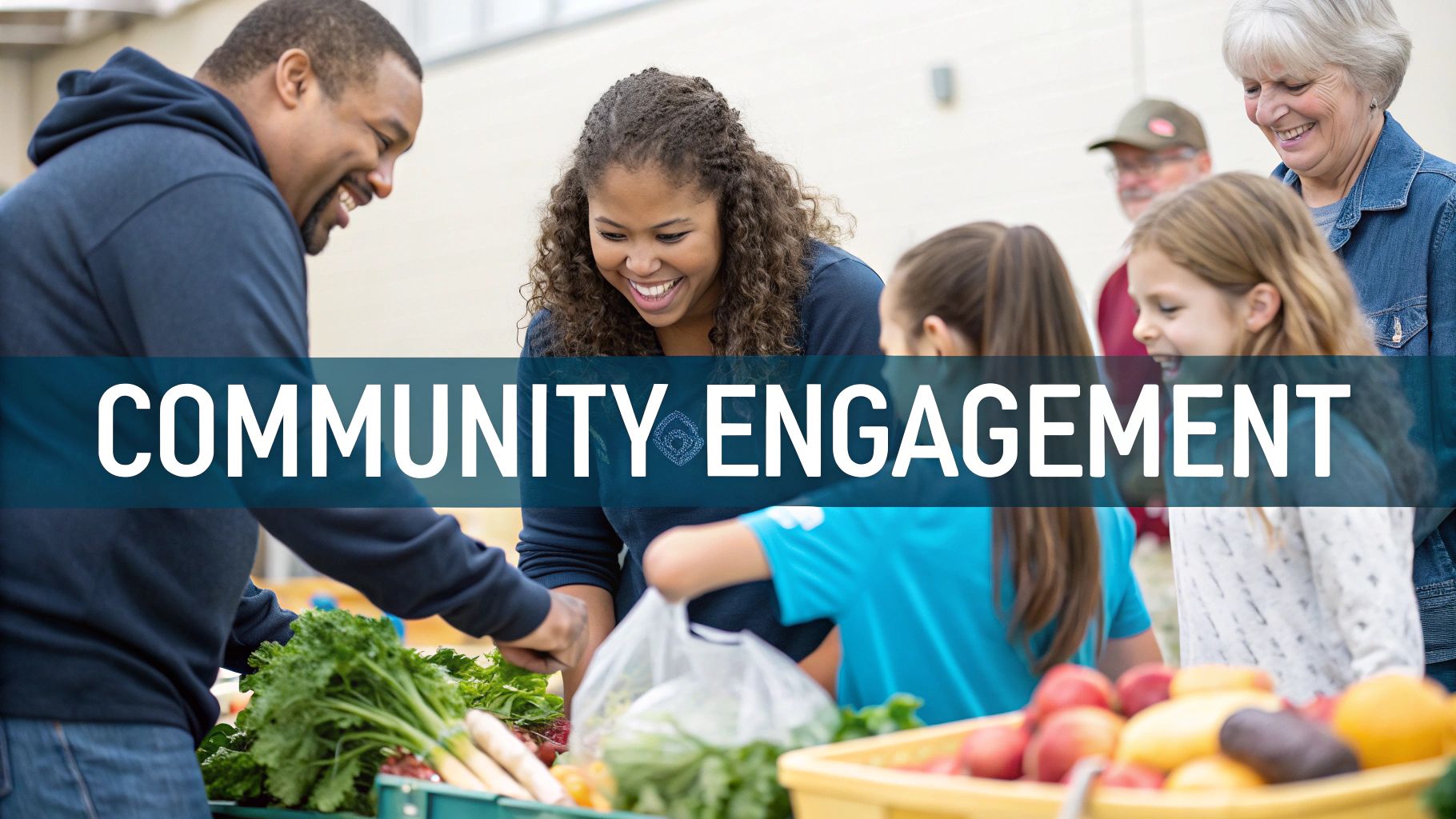
Any seasoned after-school meals provider knows the mission goes way beyond just the food. The programs that truly make a difference are built on connection. They transform mealtime into a positive, engaging community experience.
This isn't something that happens by accident. It requires a deliberate focus on the human element—actively bringing students, parents, and local partners into the fold to create a program that feels like it truly belongs to the community it serves.
Simply handing out meals isn't enough. If you want to maximize participation, the program has to become a desirable part of a child's day. When students and families feel heard and valued, they become your greatest champions.
Activating Student and Parent Voices
The fastest way to boost engagement is to listen. Kids have surprisingly strong opinions about food, and ignoring their preferences is a surefire way to watch participation numbers drop. Parents are your boots on the ground, your direct link to the community, and they can offer priceless insights into what’s working and what isn’t.
Creating simple, direct channels for feedback is the key to making families feel invested.
- Simple Menu Surveys: A QR code on a meal bag or a simple paper form at the pickup site can work wonders. Ask kids to rate new menu items with smiley faces or on a simple 1-5 scale.
- Parent Advisory Groups: Get a small, informal group of parent volunteers together quarterly. This creates an invaluable, direct line for feedback on everything from menu variety to pickup times.
- Suggestion Boxes: It's low-tech, but it works. A sealed box at each site gives students and parents a place to anonymously share ideas or flag concerns.
This feedback loop does more than just help you plan menus—it shows you respect their input and builds trust. When you actually implement a popular suggestion, like adding a yogurt parfait day, it sends a powerful message that their voices matter. That's how you build a real sense of ownership.
Umoja Best Practice: We always encourage our partners to communicate the program's benefits clearly and consistently. Use school newsletters, signs at each site, and even text message alerts. Don't just list what's on the menu; highlight how the program supports student learning, health, and family budgets. Positive, benefit-driven communication is everything.
Fostering Local Partnerships for Sustainability
For a program to last, it needs to be woven into the very fabric of the community. Building a network of local partnerships creates a resilient support system that extends your reach and impact far beyond what you could do alone. These relationships can bring in new resources, volunteers, and a much deeper connection to the families you serve.
It’s an "all-hands-on-deck" approach that makes the program a true community endeavor.
- Engage Local Farmers: Launching farm-to-school initiatives is a win-win. You improve meal quality with fresh, local produce and you support your local economy at the same time.
- Partner with Food Banks: Work together on sourcing shelf-stable items, coordinating holiday meal boxes, or even sharing warehouse space to cut down on operational costs.
- Recruit Community Volunteers: Tap into local service clubs, high school volunteer programs, or faith-based organizations to get help with meal packing and distribution.
This collaborative model is gaining serious momentum. Between 2020 and 2024, worldwide funding for school meal programs more than doubled, which allowed nearly 80 million more children to receive nutritious meals. This growth is increasingly fueled by national governments that see these programs as cost-effective investments that also support local economies by linking small-scale farmers to their supply chains. You can read more about the surge in national school meal programs to see how this trend is shaping global food security.
Case Example: Farm-to-School Success
A provider in a rural county was getting hit with rising food costs and inconsistent produce quality. Their solution? A farm-to-school initiative. They partnered with three small, family-owned farms, all within a 20-mile radius. The initial goal was simple: get fresh apples, carrots, and lettuce for their meal kits. The partnership created a wave of local goodwill, leading to positive media coverage, a surge in volunteers, and a corporate sponsorship that secured funding for the next two years.
Proving Your Impact: How to Measure Success and Ensure Long-Term Sustainability
To keep your after-school meal program running strong year after year, you need to think beyond just counting how many meals you serve. That’s a start, but real, long-term sustainability comes from being able to prove your impact in ways that truly resonate with funders, community stakeholders, and the families you're helping.
It's about shifting from basic operational numbers to a framework that measures meaningful outcomes. When you can draw a straight line from your program to positive changes in a child’s life, you’re not just asking for support—you’re making an undeniable case for it.
Defining Your Key Performance Indicators
Your first move is to figure out your Key Performance Indicators (KPIs). These are the specific, measurable data points that will tell your program's story. A solid set of KPIs helps you track what’s working, spot where you need to improve, and clearly communicate your value.
I always recommend a balanced approach that looks at your program’s health from a few different angles.
- Nutritional Outcomes: Don't just serve food; track its quality. Are you consistently hitting or even exceeding CACFP guidelines? You could even do simple surveys with the kids to see if they're eating more fruits and veggies because of your program.
- Student Attendance and Participation: Keep a close eye on daily participation rates at every site. When kids show up consistently, it’s a powerful signal that your program is meeting a real need and that families value what you're doing.
- Participant Satisfaction: Simple feedback forms for students and parents are gold. A high satisfaction rate is a metric you can take straight to potential funders to show them the quality of your work.
These data points do more than just fill a spreadsheet; they turn your program from a simple service into a proven intervention. This is the evidence you need to build a compelling story about why your work is so critical.
Measuring Outcomes to Secure Funding
Let’s be honest: solid data is your best friend when it comes to financial sustainability. Grantors and funders want to see a clear return on their investment. Well-tracked outcomes show them exactly that—that your program isn't just feeding kids, but actively helping them thrive.
Case Example: Linking Meals to Academic Success
A provider serving several elementary schools partnered with one school to track attendance and quiz scores for participating students over a semester. They found a 15% jump in attendance on program days and a clear improvement in academic performance among kids who regularly got a meal. Armed with that powerful data linking their meal program to better educational outcomes, they secured a multi-year funding commitment.
Umoja’s Best Practices for Program Sustainability
Here at Umoja, we’ve learned from experience that long-term success for any after-school meals program provider stands on two legs: financial resilience and deep community integration. It’s about being both smart with your money and deeply connected to the people you serve.
Diversify Your Funding Streams
Putting all your eggs in one basket—whether it’s a single grant or funding source—is a recipe for disaster. You need to actively pursue a mix of funding to build a stable financial foundation. Think federal reimbursements, state grants, corporate sponsorships, and local community fundraisers.
Control Costs Without Sacrificing Quality
Always be on the lookout for ways to be more efficient. Can you tweak your delivery routes to save on gas? Can you place larger, less frequent orders with vendors to negotiate better prices? Small, consistent savings add up fast and free up cash for what really matters: the meals themselves.
Foster Robust Local Partnerships
Strong local partnerships are your lifeline. These connections with local farms, food banks, and businesses give you more than just resources. They create a network of advocates who are personally invested in your program’s success. That community buy-in is often the thing that makes or breaks a program in the long run.
The importance of this work is recognized on a global scale. As of 2022, school meal programs were serving over 407 million children worldwide. This isn't just a number; it's a growing global commitment that reflects a trend toward expanding school feeding efforts, which are even being considered as an indicator under the UN Sustainable Development Goals. You can learn more about the global scale of school meal programs and see how governments are stepping up their support. This global context just reinforces the value of what you're doing: building a sustainable, data-driven program right here in your own community.
Tackling Your Toughest Program Questions
Even the most seasoned providers run into questions. You're not alone. Here are some direct, field-tested answers to the common hurdles that both new and growing after-school meal programs face. Think of this as your cheat sheet for optimizing your operations and keeping everything compliant.
I Want to Be a Sponsor. Where Do I Even Start?
Your very first move is to get in touch with your state's administering agency for Child Nutrition Programs. They hold the keys—the application, the guidelines, and the roadmap to getting approved for CACFP or SFSP.
Generally, you’ll need to be a public or private non-profit organization. Be prepared to show them you have your act together, both administratively and financially. This means having a solid management plan and demonstrating sound financial practices right out of the gate.
A pro tip? Don't wait until you apply to get smart on the rules. Most states offer training sessions, and attending one before you submit your paperwork is a game-changer. These workshops cover the critical compliance details you'll be on the hook for from day one.
How Should We Handle Menus for Kids with Allergies?
Managing special dietary needs is all about having a clear, documented process. It's not something you can just wing. Kick things off by collecting written medical statements from parents or guardians that spell out the child's specific allergies and dietary requirements.
Next, you have to build your menu planning around safe, compliant substitutions for those common allergens. This is where staff training becomes absolutely essential. Everyone involved in prepping or serving food must understand how to prevent cross-contamination.
Clear labeling isn't just a good idea—it's non-negotiable. Every single special meal needs to be marked with the child's name and the specific accommodation. Always stick to the official CACFP guidelines for substitutions to make sure the meal is still fully reimbursable.
What Are the Most Common Audit Mistakes We Should Avoid?
Time and time again, the biggest and most expensive mistakes we see during program audits boil down to one thing: poor record-keeping. Auditors are meticulous. They will comb through your daily meal counts, attendance sheets, and every piece of procurement paperwork.
Here are the top three tripwires:
- Inaccurate Meal Counts: This is a massive red flag for any auditor. Your staff must be trained to take precise, point-of-service meal counts every single day, without fail.
- Missing Procurement Records: If you can't prove how you bought something, you can't get reimbursed for it. Always maintain a complete paper trail of your bids, vendor contracts, and invoices. A missing folder could jeopardize reimbursements for thousands of meals.
- Meal Pattern Violations: It’s often the simple errors that hurt the most. Forgetting to include milk or not meeting the grain component for the week can lead to widespread meal disallowances across your sites.
Your best defense is a good offense. Conducting your own regular self-audits will help you catch these common slip-ups long before an official reviewer walks through your door. It’s the single best way to protect your funding and your program's integrity.
At Umoja Health, we get it. We provide the compliant, shelf-stable meal kits and logistical muscle that help organizations like yours feed children with confidence. Let our team handle the complexities of meal sourcing and kitting, so you can pour your energy back into your community. Explore our solutions at https://umojahealth.com.
